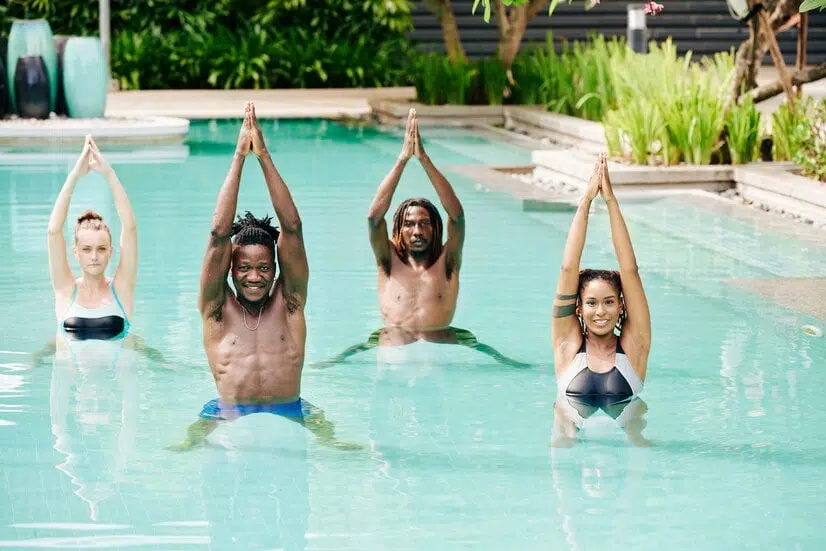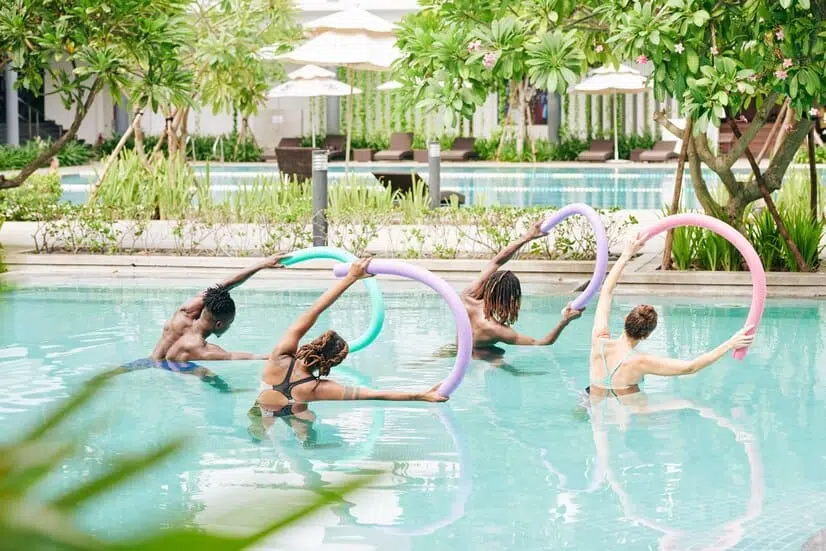Are you looking to optimize your physical fitness with an intense and fun activity? Aquadynamic or aquadynamic is the ideal solution. This aquatic discipline combines the benefits of water and the intensity of a complete training for optimal results.
Introduction to aquadynamics
In this article, we explore the basics of aquadynamics, techniques to maximize your efficiency, and a variety of exercises for each muscle group. You will also discover practical tips for planning your sessions and improving your nutrition.
Aquadynamics, still little known to the general public, is a modern aquatic discipline which is rapidly gaining popularity. Unlike classic aqua aerobics, which mainly focuses on gentle movements and stretching exercises, aquadynamics offers a more intense and structured approach. Born from the combination of hydrotherapy and the principles of cardio training, this practice aims to maximize the benefits of water for a complete and dynamic workout.
Definition and origins of aquadynamics
Aquadynamics is defined as a series of physical exercises performed in water, specifically designed to take advantage of the natural resistance of water and improve physical fitness. Originating in the Nordic countries, this discipline was developed by physiotherapists and sports trainers seeking to offer an effective alternative to traditional land-based training. The main goal of aquadynamics is to tone muscles, improve flexibility, and increase cardiovascular endurance, all with minimal impact on the joints.
Differences from classic aquagym
While aquagym Classic is often seen as a gentle activity, accessible to all, aquadynamics is aimed at those looking to intensify their training. Aquadynamic movements are faster, more energetic and require sustained effort. Indeed, aquadynamics integrates exercises such as jumps, aquatic sprints and resistance movements with specific equipment such as aquatic dumbbells. These differences make aquadynamics an ideal option for those who want to burn calories, increase muscle strength, and improve overall fitness.
Overview of the benefits and exercises covered in the article
The benefits of aquadynamics are numerous. By exploiting the resistance of the water, each movement becomes more difficult to perform, which strengthens muscles more effectively than a land-based workout. In addition, water provides natural support, reducing the risk of injury and allowing you to work often neglected muscle groups. In this article, we will cover in detail a variety of specific aquadynamic exercises, covering different muscle groups, cardio exercises, as well as techniques to maximize the effectiveness of your training. You will also discover how to structure an aquadynamic session, the prerequisites necessary to get started and practical advice to optimize your practice.
By following this comprehensive guide, you will be equipped to get the most out of every aquadynamics session and achieve your fitness goals. Get ready to dive into the dynamic and refreshing world of aquadynamics!
The basics of aquadynamics
Diving into the world of aquadynamics requires understanding its foundations and specificities. This section will guide you through the essential elements to begin this practice, covering basic movements, the importance of intensity and rhythm, as well as the benefits for your physical and mental fitness.
Understanding aquadynamics
Aquadynamics relies on specific movements designed to maximize water resistance and thus increase training effectiveness. Here are the basic movements to know:
- Aquatic Jumping Jacks : similar to their terrestrial counterparts, these movements consist of jumping by spreading and tightening the legs and arms. Water adds extra resistance, strengthening the leg and arm muscles.
- Aquatic Squats : by squatting then getting up, the leg muscles, particularly the quadriceps and glutes, are used intensely thanks to the resistance of the water.
- Aquatic Sprints : running in place or in a straight line in the water allows you to work on your cardio effectively while using the muscles of the legs and trunk.
Intensity and rhythm are crucial in aquadynamics. Unlike exercises outside of water, where the impact on the joints can limit intensity, water provides support that allows you to maintain a high pace without risk of injury. It is recommended to vary the intensity by alternating periods of intense effort with active recovery phases.
Importance of intensity and rhythm
The intensity of aquadynamic exercises can be adjusted by changing the speed and amplitude of movements. The faster you move, the more the resistance of the water increases, intensifying the muscular effort. Likewise, large and sweeping movements increase the resistance and therefore the intensity of the training. It is important to find a balance between intensity and endurance to avoid excessive fatigue and maximize benefits.
Benefits for fitness and mental health
The advantages of aquadynamics are multiple. On a physical level, this discipline allows:
- Overall muscle strengthening : Each movement performed in the water engages several muscle groups, providing a complete workout.
- Improved cardiovascular endurance : Aquatic cardio exercises increase heart rate and improve lung capacity.
- Flexibility and mobility : water helps stretch muscles and increase flexibility without risk of injury.
On a mental level, aquadynamics also offers considerable benefits:
- Stress reduction : the calming effect of water and physical exercise combined help reduce stress levels.
- Improved mood : like any exercise, aquadynamics stimulates the production of endorphins, the hormones of happiness.
- Concentration and mental clarity : Focusing on movement and breathing in water helps improve concentration and clear the mind.
Prerequisites before starting
Before diving into an aquadynamic session, it is important to check certain prerequisites to guarantee a safe and effective practice.
Although aquadynamics does not require you to be an expert swimmer, it is important to feel comfortable in the water. Basic knowledge of swimming techniques and comfort in deep pools is recommended.
For an aquadynamic session, you will need:
- Comfortable swimsuit : choose a swimsuit that offers good support to facilitate movement.
- Aquatic accessories : Aquatic dumbbells, webbed gloves and floats can be used to increase resistance and vary the exercises.
- Water shoes : they provide better grip and protect the feet on rough surfaces.
Aquadynamics is accessible to everyone, but it is advisable to have a basic physical condition to fully benefit from the sessions. Consult a doctor if you have any special medical conditions or concerns about your health before starting.
Structure of an aquadynamic session
To fully benefit from the benefits of aquadynamics, it is essential to correctly structure each session. A typical session consists of different phases that allow you to work on all aspects of physical fitness, while ensuring safe and efficient progression.
The 9 phases of a typical session
An aquadynamic session is generally broken down into nine key phases, each with a specific role in the workout.
- Warming up : Start with a 5-10 minute gentle warm-up to prepare your body for exercise. Simple movements like water walking, arm circles, and leg swings are great for gradually increasing body temperature and heart rate.
- Arm work : For 10 to 15 minutes, focus on arm exercises. Use water dumbbells or webbed gloves to add resistance. Movements like biceps curls, triceps extensions, and arm rotations are particularly effective.
- Leg work : Next, spend 10 to 15 minutes working the legs. Exercises such as water squats, lunges and knee raises help tone the muscles in your thighs, calves and glutes.
- Core work : Then spend 10 minutes on core exercises. Aquatic core, trunk rotations with a board and leg raises work the abdominal and lumbar muscles, thus strengthening the center of the body.
- Cardio phase : Follow up with 15 to 20 minutes of cardio. Exercises like tread water running, sprints, and tuck jumps increase heart rate and improve endurance.
- Return to calm : Gradually reduce the intensity over 5 minutes with slower movements like water walking and arm swings.
- Dynamic stretches : Then spend 5 minutes doing dynamic stretching to improve flexibility. Focus on the muscles used during the session, such as the quadriceps, hamstrings, shoulders and back.
- Recovery : Allow yourself 5 to 10 minutes of active recovery by floating on your back or practicing gentle movements to promote muscular and mental relaxation.
- Static Stretches : Finish with 5 to 10 minutes of static stretching to prevent soreness and improve flexibility. Focus on each muscle group, holding each stretch for 20 to 30 seconds.
Recommended duration and intensity
The ideal duration of an aquadynamic session generally varies between 45 and 60 minutes, depending on your fitness level and personal goals. Here are some tips for managing intensity:
- Beginners : Start with sessions of 30 to 45 minutes with moderate exercise phases and regular breaks. Focus on technique and correct execution of movements before increasing the intensity.
- Intermediaries : Extend your sessions to 45 to 60 minutes, incorporating longer cardio phases and more intense muscle strengthening exercises.
- Advances : For an intensive workout, add high intensity phases and complex movements. Vary the exercises to maintain interest and maximize results.
By adjusting the duration and intensity of your sessions, you will be able to progress at your own pace while benefiting from the many advantages of aquadynamics.
Top 10 aquadynamic exercises to try
Aquadynamics offers a variety of exercises targeting different muscle groups and improving cardio endurance. Here are the 10 best exercises to try to optimize your aquadynamic training.
Lower body exercises
- Aquatic Jumping Jacks Aquatic jumping jacks are excellent for strengthening the legs and arms. Standing in waist-deep water, spread and tighten your legs while raising and lowering your arms sideways. The resistance of the water makes each movement more difficult, intensifying the workout.
- Aquatic Squats Water squats target the quads, hamstrings and glutes. Stand straight with your feet shoulder-width apart. Lower yourself into a squat position, then slowly rise back up. Repeat the exercise, maintaining good back and knee alignment.
- Alternating Lunges Alternating lunges in the water intensely work the leg muscles. Take a big step forward with one leg and lower the back knee toward the bottom of the pool. Alternate legs and maintain a consistent pace to maximize efficiency.
Upper body exercises
- Push-ups on the edge of the pool Place your hands on the edge of the pool, shoulder-width apart. Extend your legs behind you and lower your chest toward the edge by bending your elbows, then push yourself back up. This exercise strengthens the chest, triceps, and shoulders.
- Arm rotations with aquatic dumbbells Hold an aquatic dumbbell in each hand. Standing in chest-deep water, perform circular rotations with your arms to work your shoulders and biceps. Vary the size and speed of the circles to adjust the intensity.
Cardio exercises
- Aquatic race on site Run in place, raising your knees high and moving your arms vigorously. This cardio exercise improves endurance and strengthens leg muscles. Try to maintain a fast pace to maximize cardiovascular benefits.
- Group jumps Jump, bringing your knees together towards your chest, then land in a standing position. Repeat quickly for an intense exercise that increases heart rate and works leg and core muscles.
Core exercises
- Aquatic sheathing Use a plank or float horizontally in the water, contracting your abdominal muscles to maintain the position. This exercise strengthens the core, improves balance and stability.
- Trunk rotations with plank Hold a plank in front of you and rotate your trunk from left to right. This exercise works the obliques and lower back muscles, contributing to a stronger and more stable core.
Recovery exercise
- Water stretching After an intense session, water stretching helps relax muscles and improve flexibility. Focus on the main muscle groups worked, such as your legs, back and arms. Water supports movement, reducing the risk of injury and promoting rapid recovery.
Techniques to maximize the effectiveness of exercises
To get the most out of your aquadynamic sessions, it is essential to master certain specific techniques. These tips will help you optimize every movement, increase the intensity of your workouts and prevent injuries. Here's how to maximize the effectiveness of your aquadynamic exercises.
Correct use of water resistance
One of the main advantages of aquadynamics is the natural resistance of the water, which makes each movement more difficult and therefore more efficient. To use this resistance to your advantage:
- Principle of aquatic resistance : The faster you move through the water, the greater the resistance. Perform your movements vigorously to increase the difficulty and effectiveness of each exercise.
- Movement Adjustment : Vary the amplitude and speed of the movements to modulate the intensity. For example, larger movements with the arms and legs increase the contact surface with the water, intensifying the resistance.
Importance of posture and technique
Good posture and correct technique are essential to avoid injury and maximize results. Here are some key tips:
- Body alignment : Keep your back straight and abs engaged to stabilize the core. Avoid leaning too far forward or backward.
- Position of feet and hands : Position your feet firmly on the pool floor for good stability. Use your hands to create additional resistance by opening them wide during the movements.
- Breathing : Regular and controlled breathing improves endurance and effectiveness of each exercise. Inhale deeply through your nose and exhale slowly through your mouth.
Progression and variation of exercises
To avoid monotony and continue to progress, it is important to vary your exercises and adjust the difficulty according to your level.
- Adaptation according to level : Start with simple movements and gradually increase the complexity and intensity. For beginners, focus on basic exercises with little resistance, then add equipment like water dumbbells to increase the difficulty.
- Variation of sessions : Alternate the types of exercises and the muscle groups worked for a balanced session. For example, combine lower and upper body exercises with cardio phases for a complete session.
- Maintaining motivation : Vary the sessions by using different aquatic equipment and changing the pace. Incorporate personal challenges or specific goals to keep your motivation high.
By applying these techniques, you will maximize the effectiveness of your aquadynamic sessions and achieve your fitness goals faster and more effectively.
Practical advice to optimize your practice
To fully enjoy the benefits of aquadynamics, it is essential to adopt some good practices. Here are some practical tips to optimize each session and maximize your results.
Session planning
Proper planning is crucial to maintaining a regular and effective practice of aquadynamics.
- Recommended frequency : For optimal results, aim for three to four sessions per week. This allows you to benefit from the cumulative effects of training while still giving your body enough time to recover.
- Example of weekly schedule :
- Monday: Full session with lower body exercises and cardio.
- Wednesday: Session focused on upper body and core.
- Friday: Mixed session with a focus on resistance and stretching.
- Saturday: Light active recovery and stretching session.
Nutrition and hydration
A balanced diet and adequate hydration are essential to support your aquadynamic efforts.
- Dietary advice before the session : Eat a light, balanced meal about 1 to 2 hours before training. Opt for complex carbohydrates, lean proteins and vegetables. For example, a quinoa salad with grilled vegetables and chicken is a good option.
- Nutrition after the session : After exercise, choose foods rich in protein to help muscle recovery. A protein smoothie or Greek yogurt with fruit are great choices.
- Importance of hydration : Drink water before, during and after your session to avoid dehydration. Practicing aquadynamics can mask signs of dehydration, so drinking regularly is crucial.
Precautions and contraindications
Adopting appropriate precautions guarantees a safe and enjoyable practice of aquadynamics.
- Warm-up and cool-down : A good warm-up prepares your body for exercise and reduces the risk of injury. Likewise, a recovery phase with stretching helps prevent soreness and promotes muscle relaxation.
- Adaptation of exercises according to your physical condition : Listen to your body and adjust exercise intensity based on your fitness level. Do not hesitate to use flotation accessories to facilitate certain movements if necessary.
- Prior medical consultation : If you have any pre-existing medical conditions, injuries, or special health concerns, consult a physician before beginning aquadynamics. This is especially important for people with heart disease, arthritis or joint problems.
By following these practical tips, you will be able to optimize each aquadynamic session, ensuring constant progress and an enjoyable experience.
Conclusion
Aquadynamics is a dynamic discipline that combines the benefits of aquatic exercise and intensive training. By following a proper session structure and using the right techniques, you maximize the results of your training. This practice is accessible to everyone, with adaptations depending on your level and physical condition.
Varied lower and upper body exercises, as well as cardio and core exercises, provide a complete workout. Good planning, a balanced diet and adequate hydration are essential to optimize your practice. Remember to consult a healthcare professional if necessary.
Go aquacycling with Aqua By
Never tried aquabike? Aqua by is the ideal place to discover this activity in an innovative way!
Our 45-minute sessions combine sport and relaxation, exploiting the benefits of water. Led by dynamic coaches, our group classes offer fun and efficiency for everyone.
At Aqua by, everyone is welcome, whatever your sporting level. Our sessions are suitable for all abilities. Also enjoy our sauna and hammam for total relaxation.
Tempted? Book your aquabike session and immerse yourself in the world of Aqua by! Our studios in Paris (Réaumur, Bastille, Charonne) and Boulogne await you.







